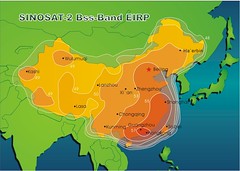We’ve written before about the nexus between IPTV and satellite communications technology, including SES Americom’s IP-PRIME (which recently signed up more than 120 channels through transport agreements with leading television programmers and networks) — but what about IP Radio?
Companies like Barix (whose consumer products can be viewed here) utilize IP radio and satellite technology for IP connections as a backup against studio power outages, as Radio World reports:
Barix AG said Clear Channel Satellite Services is using its products for point-to-multipoint IP connectivity from Englewood, Colo., to Clear Channel radio towers in the southeastern United States….
The system was launched in June in advance of the hurricane season and connects stations in the Gulf region. Stations there “now can remain on the air in the event that studios go dark in extreme weather or other disaster conditions, allowing stations to broadcast important information to local populations in emergency situations,” the supplier stated.
Englewood streams audio to towers sites in preparation for broadcast should studios experience power outages. Barionets at those sites are used to activate and switch the Exstreamer backup audio feed for transmission over the air. The latter devices are controlled from Englewood via the IP connection established over the satellite.
Stations in Texas, Louisiana, Alabama, Mississippi, Florida, Georgia, and the Carolinas are connected; the broadcast group hopes to expand the system to around 900 towers over the next year.
Such systems provide important redundancy to over-the-air broadcasts, but radio (eh, Marconi?) is not just about broadcasting from one to many — it’s about multi-point, multi-way communications, as well.
Which, when you think about it, is exactly the model upon which internet protocol is designed. So why aren’t we seeing more IP Walkie Talkies?
Well, we may soon. Cisco last fall announced technology and a new business unit "focused on integrating two-way radio, cellular, VoIP and other communications methods into an IP backbone:"
The IP Interoperability and Collaboration System (IPICS) consists of existing Cisco products and new server software that Cisco says will let public safety organizations and companies IP-enable two-way radio voice traffic and integrate disparate radio infrastructures with other public safety or private organizations.
While initially focused on public safety and government users – patching together systems of separate police, fire and governmental organizations, for example – Cisco says the IPICS platform will appeal to a broad range of public and private enterprise customers because the system also is capable of integrating disparate data and video signals with an IP infrastructure.
"[IPICS] is not a communications system in itself; it’s something that enables disparate communication systems out there to work together in an IP format," says Brad Curran, an industry analyst with Frost and Sullivan who tracks government and military communications technology industries.
Cisco Systems president and Chairman John Chambers recently gave the keynote address (more info here) and a demonstration of IPICS at the Security Standard Conference in Boston:
IPICS focuses on voice interoperability across multiple networks, and provides services for user management, policy creation, and integration of diverse PTT devices. But Chambers said its underlying architecture would enable IPICS to extend beyond voice to provide complete information-based interoperability and collaboration, with the contextual integration of voice, video, and data resources.
The potential for a company as large as Cisco to transform IP Radio and push past the barriers of interoperability should not be underestimated. Indeed, it could be as transformative as radio itself.
Before radio, after all, instant communications across great distances relied upon point-to-point connections via the telegraph. Today’s networks similarly limit communications to those with devices capable of communicating on those networks. True interoperability — a result of the nexus between satcom, IP and radio — could literally change the way we communicate.
But then, as Rocket Scientists (cough, cough), we’ve always been excited by the potential of new technology.



 who would ping-ping-ping around the Old Southwest, where he was a sheriff — backed up by deputy Droop-a-long, who was not nearly as fast.
who would ping-ping-ping around the Old Southwest, where he was a sheriff — backed up by deputy Droop-a-long, who was not nearly as fast.

 organizing and promoting the emerging sport of rocket racing, and, thus may soon be ready for actual competition. Yesteraday, the
organizing and promoting the emerging sport of rocket racing, and, thus may soon be ready for actual competition. Yesteraday, the  American entrepreneur Anousheh Ansari
American entrepreneur Anousheh Ansari 